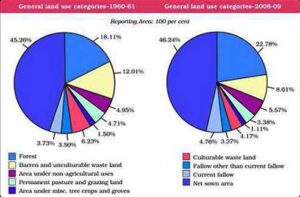7 Geography questions from Resources and Development which can create trouble to class X students if ignored. These questions are often neglected by many students. After going through many sample and previous years question papers, these 7 Geography questions have been selected for you. These 7 Geography questions can help you score 12 to 15 percent marks extra https://www.ncert.nic.in/ncerts/l/jess101.pdf.
7 Geography questions which can trouble class X students in Board exam
Ques 1 “Degradation of land is a cause of worry.” Give one reason to support the statement.
When the quality of land decreases and the soil starts loosing its fertility. It is known as land degradation.
It is a cause of worry because of its adverse impact on agricultural production and its effect on food security.
Picture based Geography question from Resources and Development
Q 2. Study the given data and answer the questions that follow:

Land use pattern in India given in class X NCERT Geography book
a) Explain the Land use pattern of India.
b) Why land under forest has not increased much since 1960–61.
c) What is the impact of the decrease of land under permanent pastures?
Ans)
a) Land use pattern of India:
- India’s total Geographical area is 3.28 million sq. km.
- Land use data is available for only 93 per cent of the total area.
- Land use reporting for most of the north-eastern states except Assam have not
been fully done. - we have no data available for Jammu and Kashmir disputed region.
b) Land under forests have not increased much since 1960-61 because of the:
- demand for more land to expand agriculture.
- due to developmental work and Infrastructural facilities and
- for the expansion of industries and urban areas.
c) Impact of decrease of land under permanent pasture:
- rearing of animals and livestock becomes difficult.
- it brings down the production of animal husbandry.
- It also decreases the additional source of income to the farmers.
Short Geography question from Chapter 1
Q3. Explain the concept of Resource conservation as voiced by Gandhiji.
Ans. Gandhiji voiced his concern about resource conservation in these Words:
- “There is enough for everybody’s need but not enough for anybody’s greed.”
- He placed the greedy and selfish individuals as the root cause for resource depletion at the global level.
- He was against ‘mass production’ and wanted to replace it with ‘production by the masses’.
- Indiscriminate use of resources by human beings has led to the depletion of resources for satisfying the greed of few individuals.
- Irrational consumption and over-utilization of resources leads to socio-economic and environmental problems.
HOTS Geography questions
Q 4. “The pattern of net sown area varies greatly from one state to another.” Explain with examples.
Ans. Two states with more than 80% of Net Sown Area are Punjab and Haryana because:
i) They are agriculturally rich States.
ii) have favorable climatic conditions for the growth of crops and
iii) has flat and fertile land with adequate irrigation facilities.
Two states with less than 10% of Net Sown Area are Arunachal Pradesh and Mizoram because:
i) The nature of land is hilly and forested, therefore availability of arable land is less.
ii) Economic backwardness. and
iii) climatic conditions also do not encourage large scale agricultural activities.
Q 5. Mention the efforts made at Global level for ‘Resource conservation’.
Ans. Efforts made at global level for ‘resource conservation’ were:
i)Firstly, In 1992, the first ‘International Earth Summit’ was held in Rio de Janeiro in Brazil, for addressing urgent problems of environmental protection and socio-economic development at the global level.
ii) In 1974, the Gandhian Philosophy was presented by Schumacher in his book “Small is Beautiful”.
iii) Moreover, the concept of ‘sustainable development’ was advocated as a means for resource conservation.
Most important Geography questions from Resources and Development
Q6. Describe the features of Red and Laterite soil. Also mention the places where they are found in India.
Ans.
1)Features of Red soils are:
- Red soil develops reddish color due to diffusion of iron in Crystalline and Metamorphic rocks,
- It looks yellow in a hydrated form.
- They are highly porous and fertile and important for food security.
2) Places:
i) One may find Red soil in areas of low rainfall in the Eastern and Southern parts of the Deccan plateau.
ii) It is also in parts of Orissa, Chhattisgarh and along the the Western Ghats.
Features of Laterite soils are:
(1) Features:
- Laterite word is taken from the Latin word ‘later’ which means brick.
- Places with high temperature and heavy rainfall has this type of soil.
- Humus content is low. Manures and fertilizers make it fertile.
- lacks fertility and are of low value for crop production,
- It mainly has little clay and much gravel of red sandstones.
(2) Places:
i) Laterite soils are found in Karnataka, Kerala, Tamil Nadu, Madhya Pradesh and hilly areas of Orissa and Assam.
ii) In the hilly areas of Karnataka, Kerala and Tamil Nadu, this soil is very useful for growing Tea and Coffee,
III) Red – Laterite soils in Tamil Nadu and Kerala are more suitable for crops like Cashew.
Frequently asked Geography question in Board exam
Q7. What is soil erosion? Explain any five measures to control soil erosion?
Ans. Soil erosion is a process of gradual movement and transportation of the upper layer of the soil. Natural agents like wind and water easily erodes the top layer of soil.
5 measures to prevent soil erosion are:
- Terrace Farming
On hilly slopes, terraces act as bunds.
This prevent soil erosion by reducing the force of water.
Farmers in Japan, South-East Asia and the USA also do terrace farming.
2. Shelter Belts
Peasants plant trees in several rows to reduce wind erosion.
They act as a barrier for wind.
3. Contour Ploughing:
Contour Ploughing reduces the force of water and prevents soil erosion.
Contours act like bunds.
Contour ploughing is common in countries like Japan, China and some of the South-East Asian countries.
4. Strip Cropping –
In this system, crops are grown in alternate strips of land in order to check the effect of the winds.
5. Construction of Dams –
Rivers play an important role in soil erosion.
small dams stop the force of river.
It protects soil from erosion.
Conclusion:
After preparing these “7 Geography questions from Resources and Development”, you may like to see other questions as well. For MCQ’s and one mark questions you may click on the given link. You may find some extra questions from Resources-and-development-class-x
Do not ignore the map
Was it helpful? Give your feedback in the comment section below.




0 Comments